Chess
Notes
Edward Winter
When contacting us by e-mail, correspondents are asked to include their name and full postal address and, when providing information, to quote exact book and magazine sources. The word ‘chess’ needs to appear in the subject-line or in the message itself.
| First column | << previous | Archives [76] | next >> | Current column |
6818. Postcards (C.N. 6759)
In C.N. 6759 a correspondent presented this postcard, sent by Tarrasch to Axel Lindström in 1923:
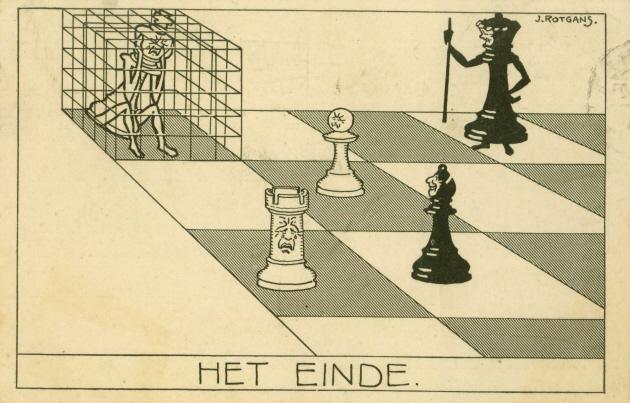
Steven B. Dowd (Birmingham, AL, USA) notes that the artist, J. Rotgans, produced a number of chess-related postcards. (There is an entry in the 1955 edition of the catalogue of the Bibliotheca van der Linde-Niemeijeriana for an undated publication from Gouda: ‘Rotgans (J.), Twaalf humoristische schaakbriefkaarten’.)
We are grateful to Jurgen Stigter (Amsterdam) for sending us copies of the illustrations (as reproduced in the weekly publication Panorama from 13 May 1925 onwards) from a scrapbook in his possession:
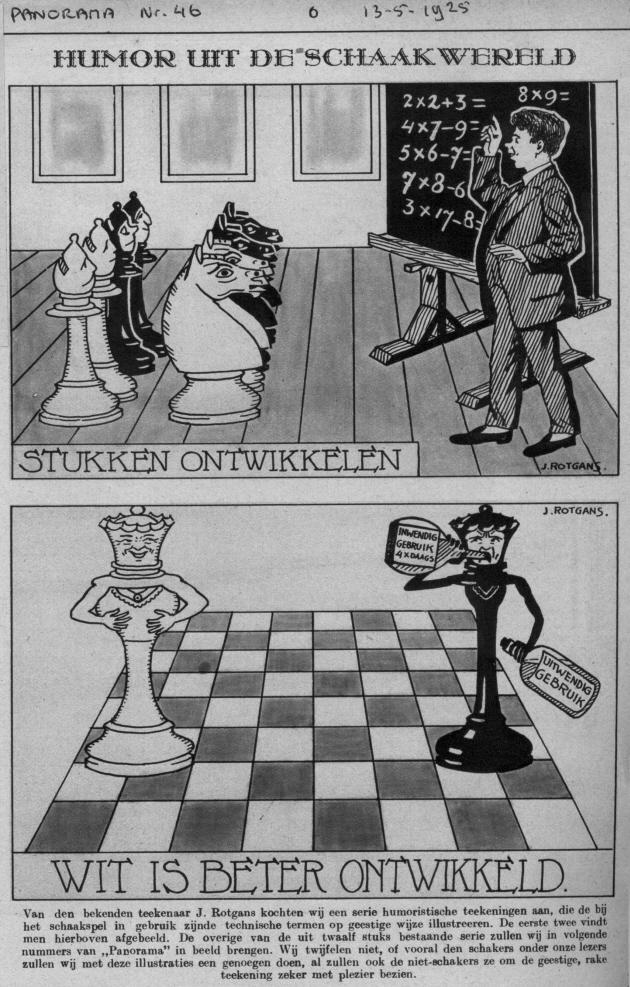
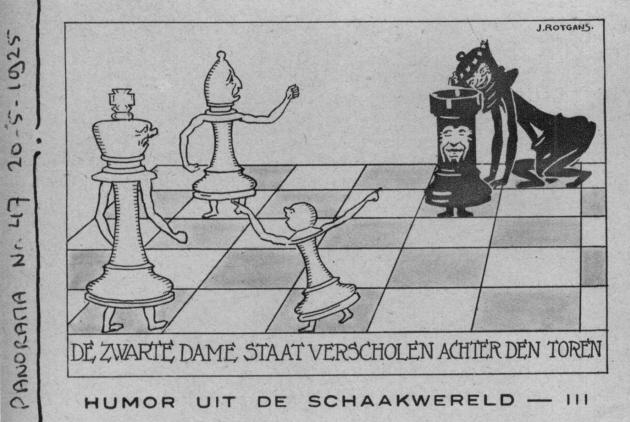
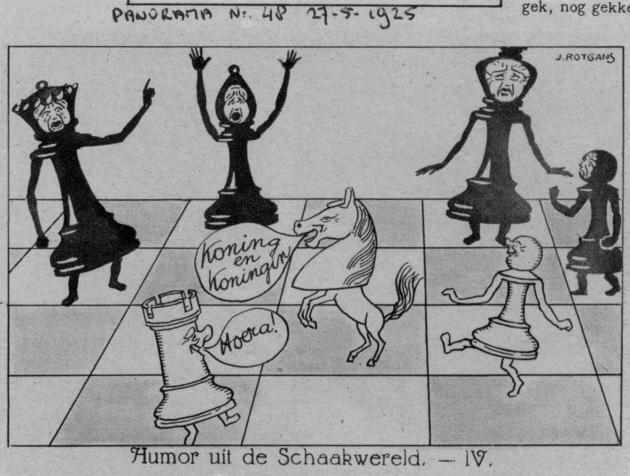
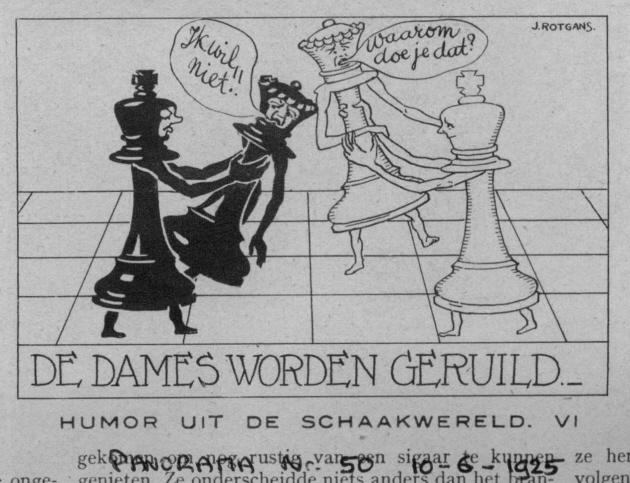
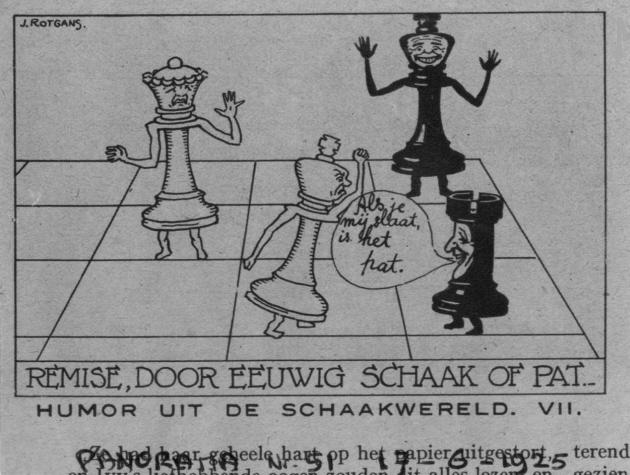
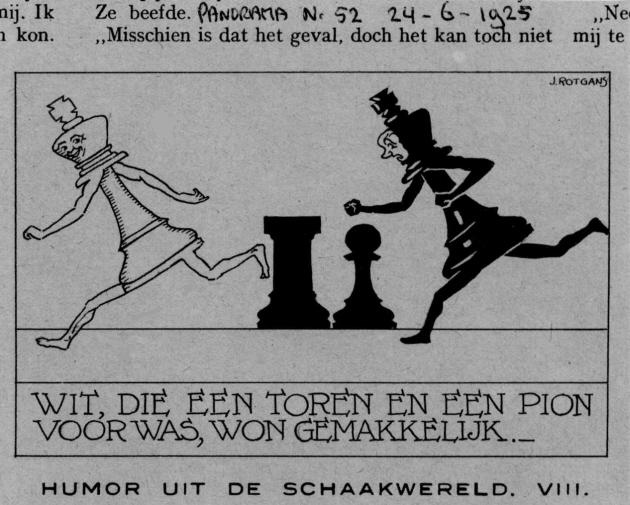

Mr Stigter also mentions that Rotgans’ name and artwork
appeared on the front and back covers of a 1927 book by
Max Euwe:
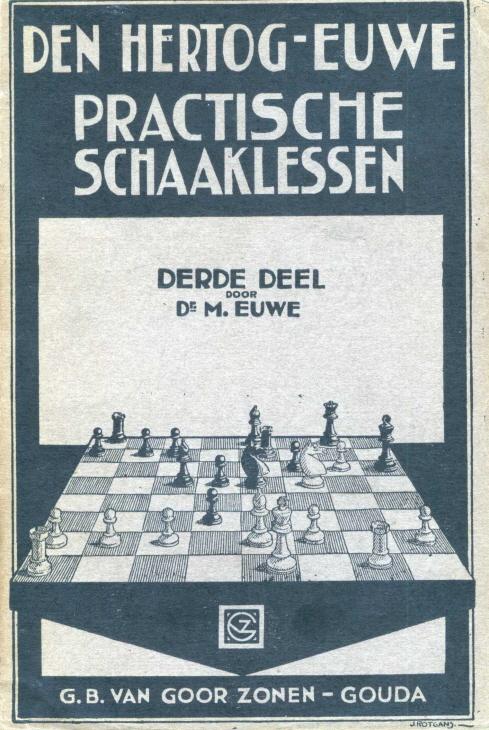
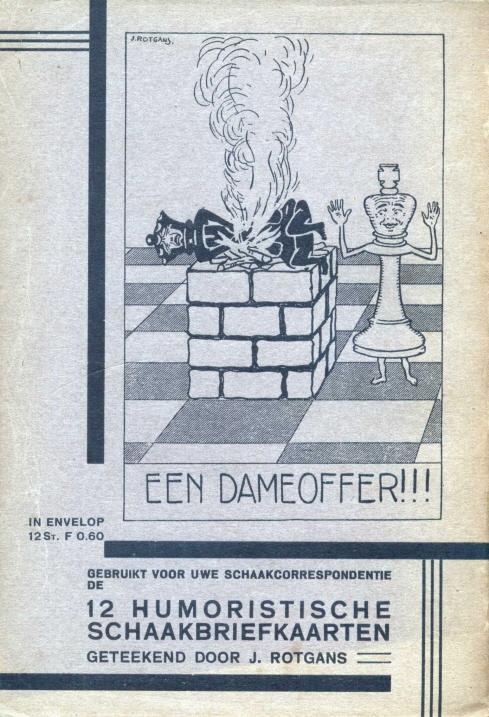
6819. Who?
From the scrapbook which was mentioned in the previous item Jurgen Stigter also provides a photograph marked ‘O. Duras?’:
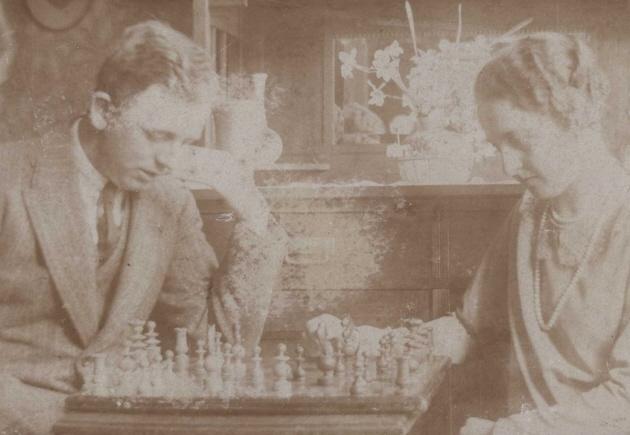
Can readers provide any further information?
6820. Teichmann v N.N.
A celebrated finish (White to move) from an odds game played in Zurich circa 1920:
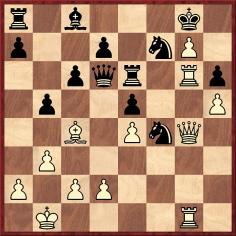
See, for instance, pages 184-185 of the August 1921 Deutsche Schachzeitung. Teichmann won with 1 Rxh6 Nxh6 2 Qg5 Nf7 3 Qd8+ Nxd8 4 h6.
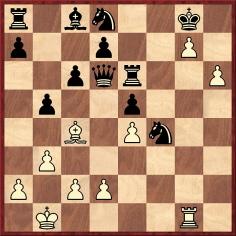
The full game-score is unavailable and, as shown on page 474 of Schachgesellschaft Zürich 1809 bis 2009 by Richard Forster (Zurich, 2009), few of the historical details are clear. Moreover, it was discovered many decades later that Black could have saved the game, and that is the focus of the present item.
On page 226 of Queen Sacrifice (Oxford, 1991) I. Neishtadt wrote that ‘in 1982 M. Dvoretsky found that in the final position [after 4 h6] Black can successfully defend’ by 4...Qd4 5 h7+ Kf7 6 g8(Q)+ Ke7 7 h8(Q) Kd6 8 Bxe6 Ndxe6.
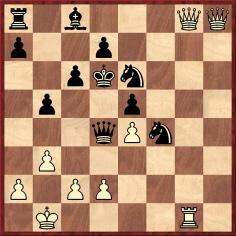
Neishtadt now observed that Black has at least equal chances ‘in the complicated battle to come’.
The following appeared on page 187 of Training for the Tournament Player by M. Dvoretsky and A. Yusupov (London, 1993):

The quiz position had been given on page 120 in a chapter whose authorship was credited to Mikhail Shereshevsky. Exactly where and when was the move 4...Qd4 first pointed out?
6821. Réti’s grave
This photograph, taken by Miloslav Salomounek, has been sent to us by Jan Kalendovský (Brno, Czech Republic):
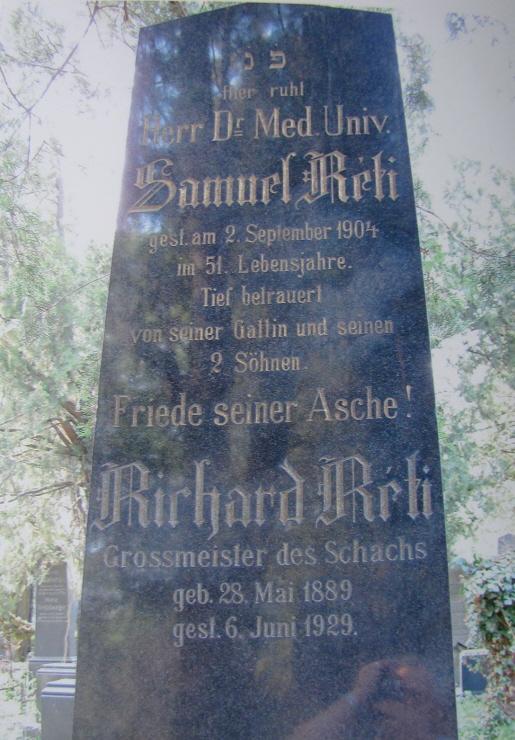
We have also received a photograph from Stanislav Vlček (Bratislava, Slovakia):
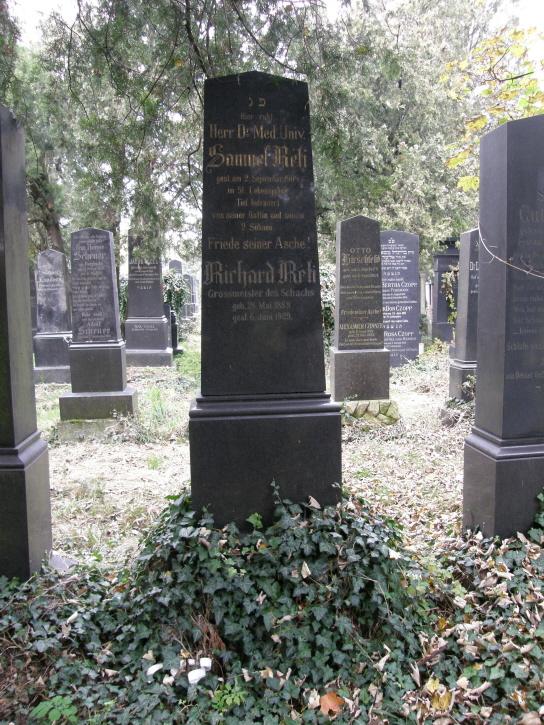
The location is the Jewish part of the Zentralfriedhof in Vienna (Section T1, Group 51, Row 5, Grave 34), and Mr Kalendovský draws attention to an article about Réti’s grave.
6822. Nimzowitsch v Alapin (C.N.s 6784, 6789 & 6799)
Jens Askgaard (Fakse, Denmark) provides another date for the Nimzowitsch v Alapin game. The Danish translation of My System (1976) had this description: ‘Frit parti, spillet i St. Petersburg maj 1914’ (Casual game, played in St Petersburg, May 1914).
Our correspondent adds that the translator, H.P. Toft, noted in his Foreword that the translation had been undertaken as early as 1941.
6823. Nimzowitsch v Behting
Javier Asturiano Molina (Murcia, Spain) asks whether the complete score of the drawn game Nimzowitsch v Behting, Riga, 1909 can be traced. Only the conclusion (from 1...Nf3+ to 15...Qd3+) was given by Nimzowitsch on pages 162-164 of the 1 April 1925 issue of Kagans Neueste Schachnachrichten and on pages 246-247 of Die Praxis meines Systems (Berlin, 1930). See also pages 352-354 of The Praxis of My System (London, 1936).
We have not found the full game but note that the last phase (ending with 16 Ke1 Qb1+) was published on page 74 of Heft 12 (dated 1910) of Baltische Schachblätter, which was co-edited by Nimzowitsch’s opponent, Carl/Karl Behting:
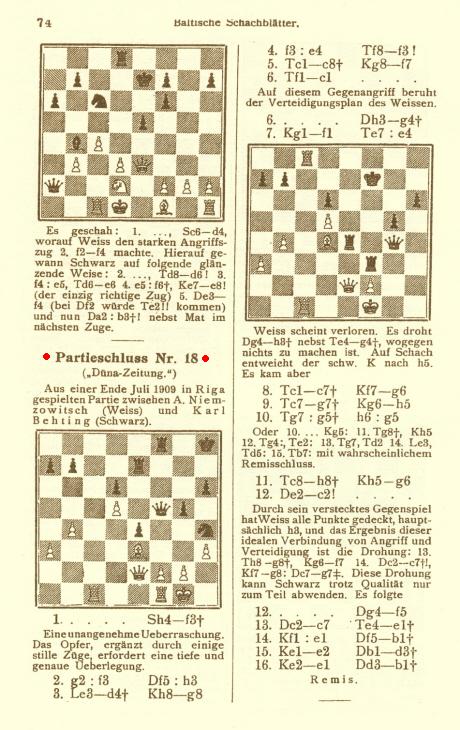
It may be remarked that in the ‘initial’ position Black’s knight is on h4 whereas Nimzowitsch placed it on e5.
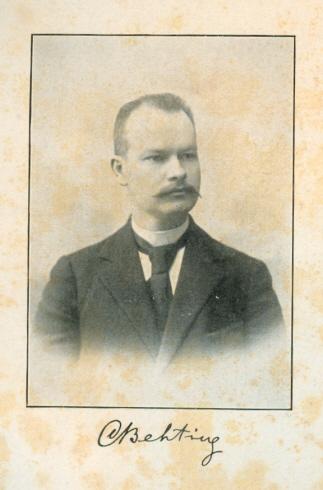
Carl/Karl Behting (Deutsches Wochenschach, 5 January 1908)
6824. Blackburne quote
On page 13 of The Wisest Things Ever Said About Chess (London, 2008) Andrew Soltis gave a source:
‘“Never commence your final attack until the queen’s rook is in play”, Joseph Blackburne wrote in his game collection.’
We have not found those words in Mr Blackburne’s Games at Chess (London, 1899), but sentiments along the same lines are regularly ascribed to the English master. See, for instance, the quotations offered by Irving Chernev on page 14 of CHESS, October 1974 and on page 22 of The Golden Dozen (Oxford, 1976). In his notes to Game 7 in Logical Chess Move by Move (various editions) Chernev gave a rather different wording:
‘Blackburne used to say, “Never start an attack until your queen’s rook is developed”.’
A second-hand version appeared on page 489 of the November 1933 BCM (in the Game Department, conducted by J.H. Blake):
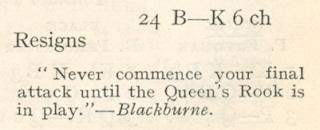
There was a more general remark on pages 19-20 of Chess Openings by F.J. Marshall (Leeds, 1904):
‘Never start an attack until the development of the fighting force is complete or well advanced.’
6825. Treatment of chess history
A former world champion’s treatment of chess history is the subject of our latest feature article.
6826. Carl Hamppe
A curious and interesting remark by Steinitz appeared on page 10 of the January 1890 issue of the International Chess Magazine. Regarding the development of the ‘modern school’ he mentioned the contribution of ‘Heydebrand, Staunton, Winawer, Paulsen, etc.’ and then referred to ...
‘... a still more important forerunner of modern play, Herr Hammppe [sic] of Vienna.’
We mentioned this in C.N. 1635, an item now available in the feature article Steinitz, Lasker, Potter and ‘Modern Chess’.
A note on Hamppe provided by G.H. Diggle (Hove, England) in C.N. 1714 is given in Chess Jottings.
6827. Vezin v Stanley
What is known about a match between Vezin and Stanley in Philadelphia in 1844? Eduardo Bauzá Mercére (New York, NY, USA) poses the question after finding this cutting (with a misspelling of Vezin’s name) on page 171 of the 16 March 1867 issue of The Field, Turf and Farm:
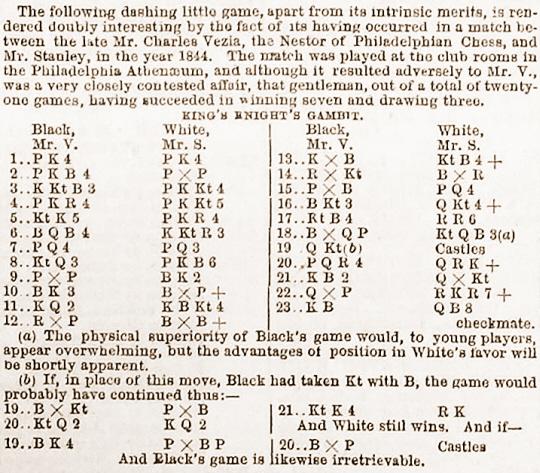
Charles Vezin – Charles Henry Stanley
Philadelphia, 1844
King’s Gambit Accepted
1 e4 e5 2 f4 exf4 3 Nf3 g5 4 h4 g4 5 Ne5 h5 6 Bc4 Nh6 7 d4 d6 8 Nd3 f3 9 gxf3 Be7 10 Be3 Bxh4+ 11 Kd2 Bg5 12 Rxh5 Bxe3+ 13 Kxe3
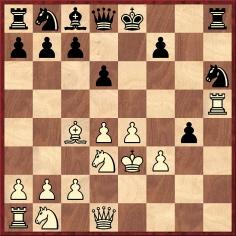
13...Nf5+ 14 Rxf5 Bxf5 15 exf5 d5 16 Bb3 Qg5+ 17 Nf4 Rh3 18 Bxd5 Nc6 19 Qg1 O-O-O 20 a4 Re8+ 21 Kf2 Qxf4 22 Qxg4 Rh2+ 23 Kf1 Qc1 mate.
6828. Alekhine in 1944
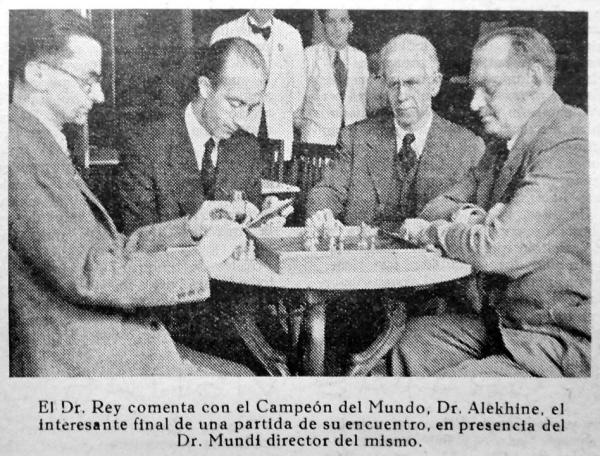
Mr Bauzá Mercére has also provided the above photograph from the Alekhine v Rey Ardid match in Saragossa, 1944. He reports:
‘It appeared in the bulletin of rounds 8-9 of the 1957 Spanish championship (27-28 October), also played in Saragossa.’
6829. Proverb and quotation
Information is requested on two items given by Irving Chernev on page 14 of the October 1974 CHESS:
- ‘It is never safe to take the queen knight pawn with the queen – even when it is safe. (Hungarian proverb)’
- ‘Capture first and philosophize later. (Tartakower)’
In the latter citation, ‘castle’, instead of ‘capture’, is sometimes seen.
6830. Morphy in Havana (C.N. 4932)
C.N. 4932 reproduced from page 27 of La odisea de Pablo Morphy en La Habana by A.C. Vázquez (Havana, 1893) an illustration of Morphy and a group of players at a chess evening (17 October 1862):
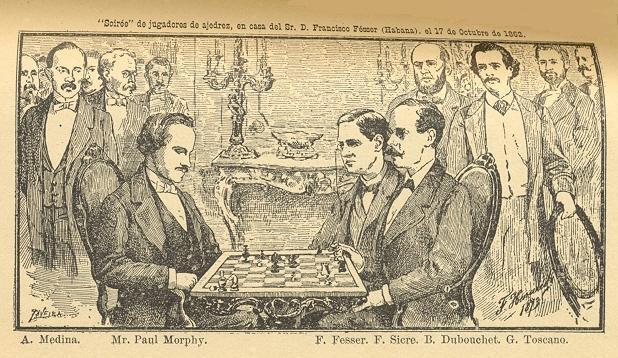
Olimpiu G. Urcan (Singapore) draws attention to a similar sketch on page 29 of El Moro Muza, 26 October 1862 (with a report on pages 30-31), available in the on-line archives of the Biblioteca Nacional de España.
Our correspondent comments that his searches for material (texts and photographs) on such masters as Capablanca and Alekhine (also with the spelling ‘Alekine’) have been particularly fruitful.
6831. Books on Carlsen
The following books on Magnus Carlsen have been added to our feature article on volumes about leading contemporary players:
- Wonderboy by S. Agdestein (Alkmaar, 2004) – plus Dutch, German and Italian editions
- The Chess Greats of the World: Carlsen by D. Lovas (Kecskemét, 2008)
- Magnus Carlsen 60 partiy lidera sovremennykh shakhmat by A. Mikhalchishin and O. Stetsko (Moscow, 2011 – sic).
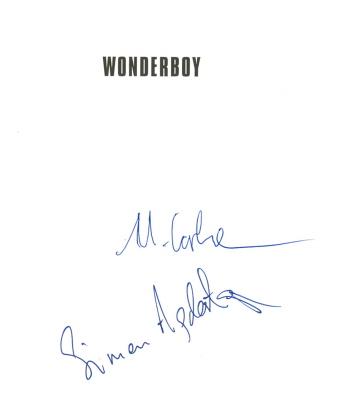
6832. Nimble expurgation
ChessBase has reproduced from The Huffington Post an article entitled ‘A Disappearing Act’ by Lubomir Kavalek. Two paragraphs:
‘In 1975 at the US Open, Navratilova asked for political asylum and became persona non grata at home. Her name disappeared from the press. It was a game the communist establishment liked to play. The censors axed your name and the people learned how to read between the lines.
I met with similar fate after I left Czechoslovakia in 1968. Chess tournaments in which I participated were not reported or appeared without my name. The same year Martina left, a book of chess puzzles by two Czech grandmasters, Vlastimil Hort and Vlastimil Jansa, was published in Prague. The publisher Olympia printed 18,000 copies and when it was done, some censors discovered my name attached to one of the games. They did something unbelievable: they cut out the page with my name, printed a new one without my name and glued it back in the book. They did it page by page, book by book – 18,000 times.’
No further details were given in Kavalek’s article, so we have examined the Hort/Jansa book, Zahrajte si šachy s velmistry.

Of the 230 positions discussed, only one lacked the players’ names:


The nimble expurgation becomes clear only on close inspection: the sheet with pages 31-32 is slightly shorter than the others.
Kavalek’s name was given in the English edition, The Best Move (Great Neck, 1980), which was translated from the Czech by Irena Kavalek:
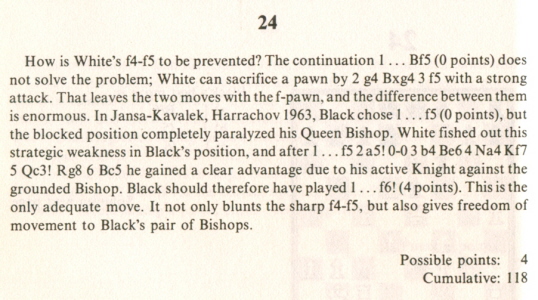
Page 16 of the Russian edition (Moscow, 1976) also included Kavalek’s name:
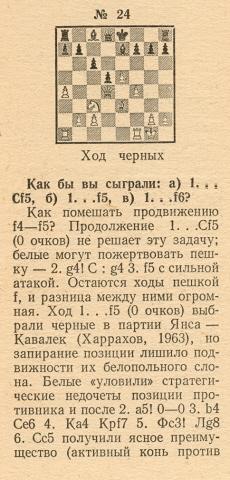
6833. John Francis Byrne
Moshe Rubin (Jerusalem) is researching John Francis Byrne (1880-1960), who lived in Dublin until 1910 and thereafter in New York City. In 1953 Byrne, a close friend and colleague of James Joyce, published Silent Years: An autobiography with memoirs of James Joyce and our Ireland, and we are grateful to Mr Rubin for sending us two chapters with much chess content.
Chapter Five (pages 48-57) is entitled ‘Congress v House of Commons at Chess’ and describes, in particular, Byrne’s games with John Howard Parnell. His encounters with some masters are related in Chapter Sixteen (‘I Lecture on Spinoza’) on pages 178-187. In the early part of the twentieth century ‘in this new Sackville Chess Club I quickly became a top chessplayer; and during several years won as many first-prize gold medals’. From pages 179-180:
‘As an indication of the standard of chess played in Dublin, I can relate a couple of facts. One afternoon in the Sackville Chess Club, I was sitting alone and unoccupied, when a middle-aged, stout and florid gentleman with a large blue patch over one eye approached me and asked me in Teutonic accent whether I would care to play a game of chess with him. I said I would and we did. And as the game progressed, I noticed to my astonishment that a big crowd of kibitzers gathered around our table. After we had played a while the game developed into what was, I knew, a winning position for me; and at this point I was amazed when my opponent suddenly stretched out his arm, swept all the pieces off the chessboard, and said, “It’s yours – will you play another?” We played again; and this time, before the game was finished he said, “It’s a draw – have another?” I refused to play a third, because I had to go away; and when I got up to leave, several members of the club clustered round me clapping me on the back, saying, “Well done, Byrne, you gave him quite a shock.” “But who is he, I never saw him before?”, I asked. “Didn’t you know? He’s Teichmann.”
Teichmann was at that time a prominent international chess master, who usually came out somewhere about fourth in the international tournaments. The Sackville Club had been in correspondence with him about giving some exhibitions in Dublin, and when he arrived he was met by Porterfield Rynd, who escorted him to the club where, without my being aware of what was afoot, he sicked him on to me. Rynd was very fond of a little practical joke. He himself was a really good player; and he knew, though I was not a student of chess, that I was a player who had a winning chance against anyone. Another chess master who came to Dublin for exhibition purposes was an Englishman named Lee. He also played in international tournaments, but usually did not do so well as Teichmann. With Lee I played a few solo games; and I felt quite sure that if I were to play a match with him I could beat him, but I also felt doubly sure that I never would play a serious match with him – or anyone else. The strange thing about Lee is that I remember him so vividly. If I were an artist, I could sketch him exactly as he appeared to me then. He looked to be in his middle fifties, about my own size, with long pasty face, grey eyes, sparse and thin greying hair brushed back from his forehead, large, but not protruding ears, thin grey moustache, a quiet manner, and soft, but slightly raucous voice, this quality in it being probably due to his continuous pipe smoking combined with his love for snuff. He wore a high collar, large cravat, frock coat, striped trousers and spats. And as I played with him and thought about him I marveled how in the name of heaven he was able to make both ends meet as an itinerant professional chessplayer. And the more I thought about Lee, or Teichmann for that matter, the less I wanted to play any professional chessplayer in those simultaneous exhibitions. In play either against Teichmann or Lee, I won a brilliancy prize; but instead of feeling elated over this, I felt sad. These fellows, I realized, were eking out a precarious existence dragging the devil by the tail, and I felt no glory in adding my poundage to his satanic majesty.
A third professional who visited Dublin in my time for exhibition purposes was the famous Blackburne. His exhibition in the Sackville Chess Club consisted of playing blindfolded against about eight players simultaneously. I was an emcee that night – relaying moves, and helping Rynd, who was a long-time personal friend of Blackburne’s, to prepare vast quantities of whiskey punch to slake the eager thirst of the aged, daddy-Christmas-looking chess master. And, inspired no doubt by his spirituous quaffing, Blackburne won a smashing victory.’
Our correspondent asks whether it is possible to find
other writings on chess by Byrne, or any of his
game-scores.
6834. Unusual notation
John Blackstone (Las Vegas, NV, USA) draws attention to an unusual chess notation explained on page 21 of the Evening Post (New York), 10 April 1897:
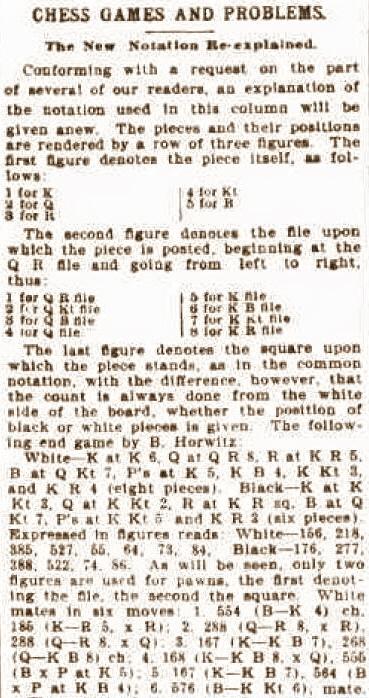
6835. Nimzowitsch v Alapin (C.N.s 6784, 6789, 6799 & 6822)
Jean-Luc Grenier (St-Jerome, Quebec, Canada) and Dan Scoones (Port Coquitlam, BC, Canada) note annotators’ failure to mention that White could have ended the game a move earlier (after 14 Bf6 Qxf6):
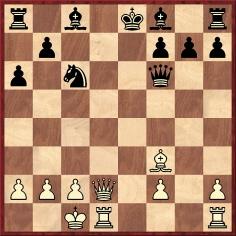
15 Bxc6+ bxc6 16 Rhe1+ and mate next move.
6836. Captain Hugh Alexander Kennedy
From Fabrizio Zavatarelli (Milan, Italy) comes a premature report of Capt. H.A. Kennedy’s death, in the 19 June 1875 issue of The Field. In such cases it is almost de rigueur for the undead to respond jocosely, and Kennedy did so in the following week’s magazine. For the full texts, see Chess and Untimely Death Notices.
6837. Machiavellian match-players
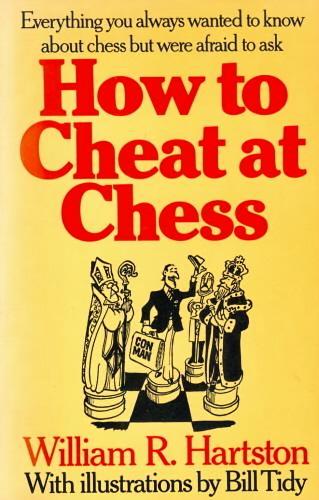
A further article by the Badmaster, G.H. Diggle, from the April 1977 Newsflash and page 21 of Chess Characters (Geneva, 1984):
‘W.R. Hartston’s disgraceful book How to Cheat at Chess (a work “without which no Badmaster’s bookshelf could possibly be complete”) was lapped up with avidity by the present BM while commuting from Lewes to Victoria. He had omitted to conceal from public gaze the brazenly gaudy title on the cover, and even before reaching Haywards Heath his fellow passengers were exchanging significant glances, while a ticket inspector on the train subjected the BM’s “Season” to a minute scrutiny before allowing him to resume his “nefarious perusal”. The BM, who after 50 years of chess gamesmanship flattered himself that he knew every trick of the trade, is forced to admit that on nearly every page of this comprehensive work some completely fresh specimen of low rascality held him captivated and enthralled.
There are, however, one or two “Irregular Openings” which Mr Hartston has omitted to notice, possibly because they may have become obsolete before his time. Perhaps the most diabolical tactician the BM ever encountered was in a rather rustic Minor County match. Before our game started he affected a sort of weary affability: “These awful matches, you know – they will keep roping me in – I much prefer to play chess for fun”, etc., etc. Then he picked up our chess clock with some revulsion: “Oh gosh, have we really got to use this contraption? Can’t we be naughty and discard the beastly thing?” On the BM replying, “Perhaps we had better do as Rome does”, he observed: “Well, just keep an eye on me, that’s all – I shall never remember to press the bleeding button, or worse still, I shall keep on pressing the one on the next board – I’m left-handed, you know.” Then we were handed our score-sheets: “What’s this blasted dossier? Name of opponent? White’s time? Black’s time? This is Chess Bureaucracy gone mad. Would you mind ‘keeping the Minutes’ – I’m sure you are one of those enlightened coves who understands this idiotic notation.” Reduced by these blandishments to a thoroughly fidgety state, the BM played “at least a rook below his usual strength” and when time was called Machiavelli was a pawn up, though with bishops of opposite colours. “It looks rather drawish”, ventured the BM. Then the villain showed the cloven hoof. “Pity I won that pawn! You know what these Match Captains are. It’ll have to go up to the House of Lords, I suppose – there must be a win somewhere, and no doubt some bore will plough through every blasted variation till he finds it. Isn’t it absurd?”’
6838. Capablanca: rule-changes and variants
The chapter ‘Changing the Rules’ in our book on Capablanca has been supplemented by C.N.s 5437, 5618 and 5619, but more needs to be discovered about the earliest occasions when the Cuban advocated modifications. There is, for instance, this quote from an unspecified interview:

Source: Deutsche Schachzeitung, June 1921, page 143.
6839. Stephen Fry (C.N.s 3972 & 4275)
The Fry Chronicles by Stephen Fry (London, 2010) frequently mentions chess. For example, pages 182-183 relate a conversation with Alistair Cooke during a dinner at Trinity Hall, Cambridge in 1981. Cooke ...
‘... talked wonderfully of his time at Jesus College in the late twenties and early thirties. He spoke of Jacob Bronowski, who had the rooms above him. “He invited me to a game of chess and as we sat down asked me, ‘Do you play classical chess or hypermodern?’”’
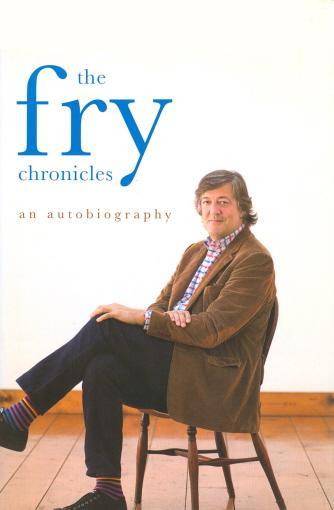
Most of the book’s references to chess concern one of Fry’s closest friends, Kim Harris. From page 81:
‘Aside from his proficiency at Latin and Greek Kim had another skill and at a level of brilliance that seemed to me to be quite superhuman. He was a chess Master. At Bolton he had played with, and to some extent mentored, Nigel Short, who was already becoming well known as the greatest prodigy England had ever produced. At the age of ten Short had beaten the great Viktor Korchnoi and now at 14 was on the verge of becoming the youngest International Master in history. Kim was “just” a Master, but that meant he was skilful enough to play blindfold, a trick I never tired of urging him to perform. Without any sight of the board he would demolish all comers.’
The term ‘Master’ is used loosely in connection with Kim Harris, but during the period in question his name appeared as a participant in Oxford v Cambridge Varsity matches. For instance, on page 243 of the June 1979 BCM Harry Golombek gave Harris’ loss to Simon Finn, who ‘produced a fine knight sacrifice that won convincingly and secured for him the prize for the best game played by Oxford’. Harris appeared in group photographs in the June 1980 BCM (page 310) and on page 162 of the May 1981 issue.
Which chess websites Stephen Fry may visit we do not know, but this general remark on page 95 may be noted:
‘... trollers on internet sites ... who specialize in posting barbarous, mean, abusive, look-at-me, listen-to-me anonymous comments on YouTube and BBC “Have Your Say” pages and other websites and blogs foolish enough to allow space for their poison. Such swine specialize in second-guessing the motives of those who are brave enough to commit to the risk of making fools of themselves in public and they are a blight on the face of the earth.’
6840. Confusion
Complications and loose ends abound in our latest feature article, entitled Confusion.
6841. Riot
Many reports are available on the Internet about a riot during the first-night performance of a play at the Shaftesbury Theatre in London. Chanting erupted in the auditorium. Leaflets and stink-bombs were unleashed, the curtain had to be lowered several times, and the police intervened to eject the demonstrators.
The protests were directed against the play’s leading man:
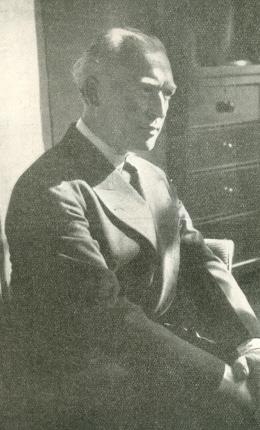
Werner Krauss
These events occurred on 28 September 1933, the protesters’ grievance being that Werner Krauss was German. The news went around the world. Page 14 of the Courier Mail (Brisbane) of 30 September 1933 stated that there were cries in the theatre of ‘Down with Hitler. We won’t let Krauss appear. We want British actors’.
The play was Before Sunset by Gerhart (also
spelled Gerhardt) Hauptmann, in an English adaptation by
Miles Malleson. The above picture of Krauss is taken from
the theatre programme, as is this synopsis:
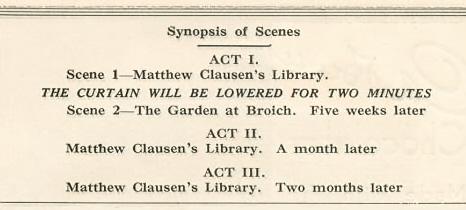
On a milder level, far removed from the concerns of the anti-Fascist movement, a complaint about the play from L.C. Birch was published on page 500 of the November 1933 BCM:
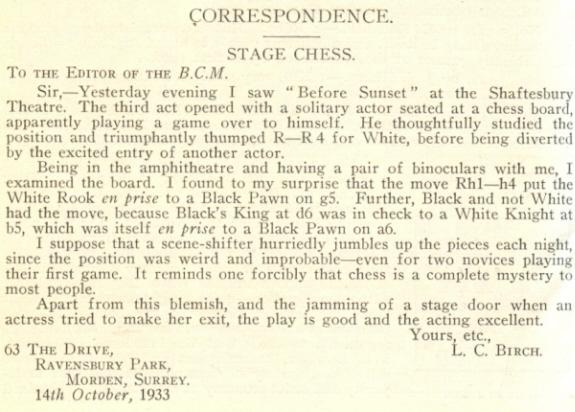
The play contains several chess-related passages, such as the following, which we reproduce from page 39 of Vor Sonnenuntergang (‘Schauspiel von Gerhart Hauptmann’ – a work in five acts), published in Berlin in 1932:
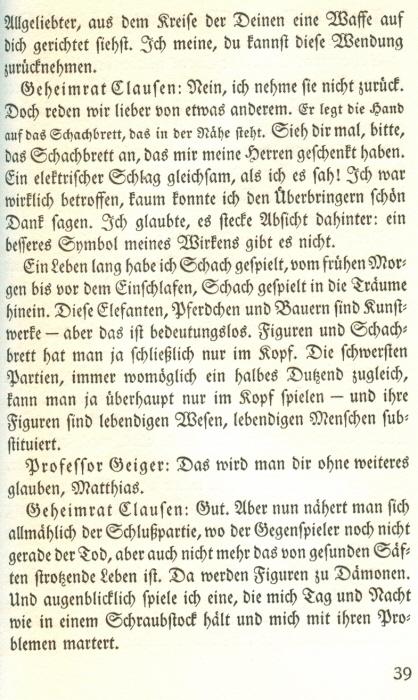
To assist us in preparing a follow-up item, does any reader have access to an English-language version of the play?
6842. Stephen Fry and Kim Harris (C.N. 6839)
From Nigel Short (Athens):
‘Kim Harris played on board one for Bolton School in my first year there (1977). He also represented Lancashire on a number of occasions during that relatively brief period when he was an active player. While I do not recall his precise rating peak, his playing strength was over 190 BCF (roughly 2200 Elo), so Stephen Fry’s loose usage of the term “master” is perhaps not that inappropriate if one makes a comparison to the title of USCF Master.’
6843. A lost work
A brief item on page 151 of the May 1952 CHESS:
‘W.E. Napier won the British Championship in 1904 then emigrated to the USA and for some years challenged Marshall and Pillsbury. His three slim volumes of Chess Amenities (selected games annotated with a delightfully light touch) are much-sought literary gems. He is suffering from advanced cancer of the throat but has written a new book Evergreen Chess.’
Napier died a few months later. The manuscript of Evergreen Chess had been conveyed to Hermann Helms but has never been traced, let alone published. Further information is available on pages 352-354 of Napier The Forgotten Chessmaster by John S. Hilbert (Yorklyn, 1997).
6844. Rook on the seventh rank
Who was the first writer to point out the value of having a rook on the seventh rank? So far, readers have offered no improvement over our tentative suggestion in C.N. 2394, i.e. the remark by William Lewis on page 9 of A Series of Progressive Lessons on the Game of Chess (London, 1831):
‘It is often good play to post one of your rooks on the adversary’s second rank, as it frequently confines his king, and towards the end of the game is generally a decisive move.’
6845. Award for beating Euwe
From page 3 of The Groningen International Chess Tournament 1946 by M. Euwe and H. Kmoch, translated and edited by B.H. Wood (Sutton Coldfield, 1949):
‘Kotov and Smyslov received a medal from Euwe which is awarded to anybody who beats him; it was well meant and well taken.’
This implies that it was Euwe’s practice to make an award to players who defeated him. However, the original Dutch text, on page 20 of Groningen 1946 Het Staunton Wereldschaaktournooi (Groningen, 1947), was:
‘Kotof en Smislof kregen samen één plaquette van Euwe, gesticht door iemand die hem die van Euwe mocht winnen wilde beloonen. Het was goed bedoeld.’ [‘Kotov and Smyslov jointly received a plaque from Euwe, at the initiative of someone who wanted to reward the person beating Euwe. It was well intended.’]
6846.
Euwe photographs
Our article Graves of Chess Masters has two photographs of the resting-place of Daniël Noteboom. We have now received from Jan Koppenaal (Noordwijk, the Netherlands), who was President of the Daniël Noteboom Chess Club from 1972 to 1997, a photograph of the funeral ceremony in 1932, with Max Euwe among the mourners.
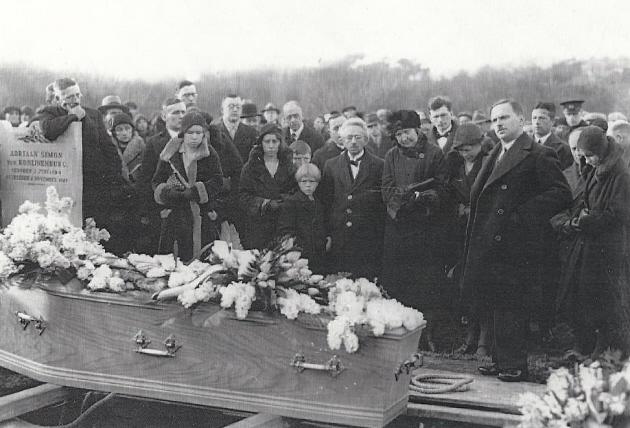
Mr Koppenaal has also sent us a photograph of Euwe with his pupils outside the Gemeentelijk Lyceum voor meisjes in Amsterdam (1930).
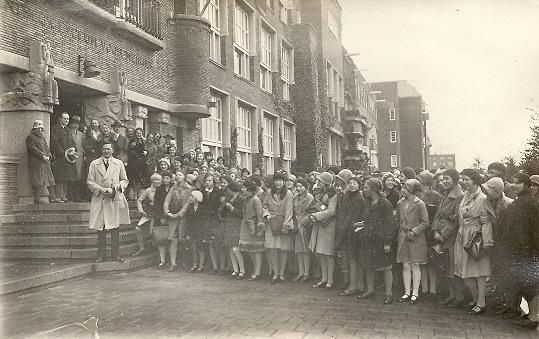
6847. Birdie Reeve
The best chess-related photograph of Birdie Reeve which we
possess is the following:
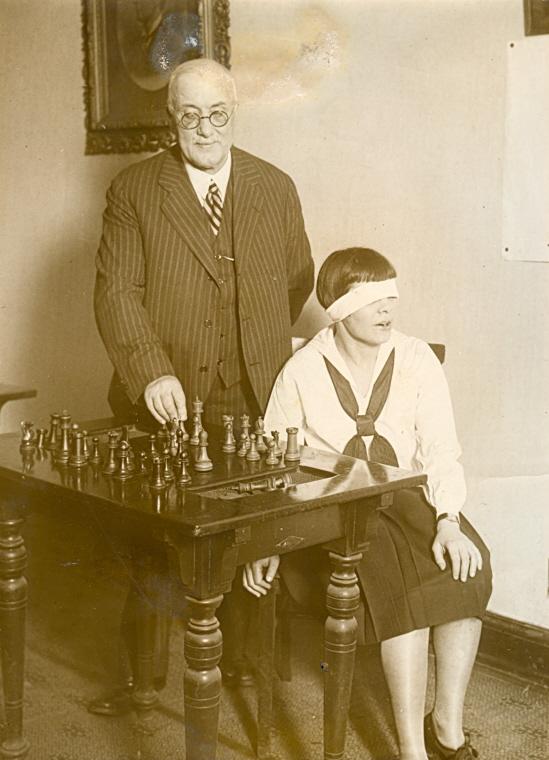
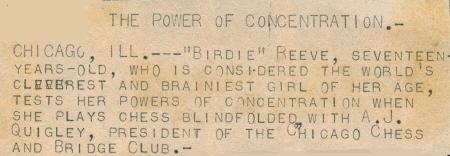
Our search for information about her chess activities continues. Does the reference to ‘A.J. Quigley, President of the Chicago Chess and Bridge Club’ provide a clue? ‘A.J. Quigley, president Chicago Chess and Checker Club’ was mentioned on pages 109-110 of the September-October 1926 American Chess Bulletin.
| First column | << previous | Archives [76] | next >> | Current column |
Copyright: Edward Winter. All rights reserved.